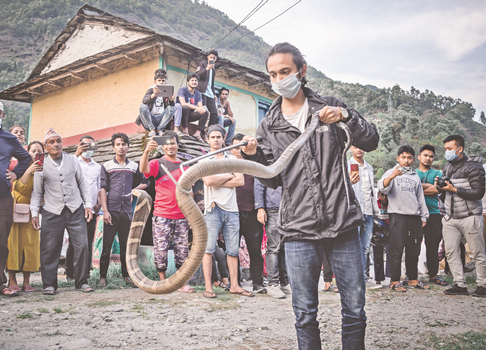Pokhara youths rescue 66 snakes during lockdown

By Tara Chapagain
Pokhara, May 15: The youths of Pokhara involved in conservation of snakes have rescued 66 snakes during the lockdown period. The youths have been rescuing snakes, which have been entering human settlements by leaving their habitats, and leaving them in safe places.
Those involved in rescuing snakes are Rishi Baral, conservation officer at Annapurna Conservation Area Project; Mahendra Prasad Katila, chairman at Snake Conservation Society Nepal; 21-year-old Rohit Giri, a BSc Biology student and seven others.
Due to the rain, snakes come out and are seen around human settlements. The youths of Pokhara, who love snakes and dedicate themselves to snake conservation, reach the place after receiving information and rescue the reptiles.
“We rescued 66 snakes during the lockdown from different places of Pokhara after we were informed by the locals. The rescued snakes include cobras, rat snakes and green snakes, among others. The service is free of cost,” said Baral.
Among the youths, Rohit Giri is in the top list of snake rescuers. Giri has been involved with snakes since he was 12.
Giri has rescued 56 snakes during the lockdown and more than 500 snakes till date.
The District Administration Office, Kaski, has even provided Giri with a pass for rescuing snakes under the recommendation of Division Forest Office, Kaski.
According to the individuals involved in snake conservation, there are 83 types of snakes found in Nepal 19 of which are venomous. Similarly, there are 35 types of snakes in Kaski alone among which five are venomous. However, the numbers of venomous snakes are subjected to increase.
How snake rescue began
It was in 2073 BS when the Snake Conservation Society Nepal was established. All the snake lovers across the country registered themselves in the society with Mahendra Prasad Katila as the chairman.
“We receive phone calls from different places and even photos. We first confirm whether the snake is venomous or not and give necessary suggestions. We only rescue snakes which have entered inside houses,” said Baral.
How snakes are captured
The rescue group reaches one’s home and investigates about the snake. They identify the snake and prepare themselves with necessary equipment for one’s own safety and equipment required to capture a snake. Once the snake is captured with a hook, they keep it inside a black cloth and then inside a sack. The house owners are given some information regarding the snakes.
The rescued snakes are then taken to a nearby jungle, not so far, since the snake needs to be near its children or eggs. The team does not disclose the specific place where the snakes are left.
Importance of snakes
According to Giri, snakes are as important as other living organisms. With the help of snakes, antidotes for snakebite and other medicines are also manufactured.
In view of snakes’ importance in medicine sector, conservationists request the government to ensure conservation of snakes and ways to manufacture medicines from them.
“The antidote for a snakebite is made from the same snake which has bitten someone. Nepal needs to be able to manufacture antidote for snakebite on its own,” said Baral.
Antidotes for snakebite are being imported from India and regarding Pokhara, it is only available in Manipal Hospital and Gandaki Hospital.
Safety measures
Snakes are mostly found in places with garbage due to which the periphery of one’s house should always be kept clean. Similarly, snakes enter houses in search of its prey such as frog and mouse. As snakes only attack when they feel danger, they should be allowed safe passage to leave and should never be teased.
In the Terai region, snakes climb to people’s bed for warmth and when an individual does not see it and touches or presses it, the snake bites him/her.
According to conservationists, there is a mark of teeth bite when a snake is venomous and a mark of scratch if it is non-venomous.
Recent News

Do not make expressions casting dout on election: EC
14 Apr, 2022
CM Bhatta says may New Year 2079 BS inspire positive thinking
14 Apr, 2022
Three new cases, 44 recoveries in 24 hours
14 Apr, 2022
689 climbers of 84 teams so far acquire permits for climbing various peaks this spring season
14 Apr, 2022
How the rising cost of living crisis is impacting Nepal
14 Apr, 2022
US military confirms an interstellar meteor collided with Earth
14 Apr, 2022
Valneva Covid vaccine approved for use in UK
14 Apr, 2022
Chair Prachanda highlights need of unity among Maoist, Communist forces
14 Apr, 2022
Ranbir Kapoor and Alia Bhatt: Bollywood toasts star couple on wedding
14 Apr, 2022
President Bhandari confers decorations (Photo Feature)
14 Apr, 2022











